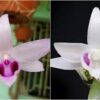# Phalaenopsis Orchids and Their Role in Local Cultural Conservation

Phalaenopsis orchids, commonly referred to as moth orchids, are not just stunning floral specimens; they are also deeply woven into the cultural fabric of many regions, especially in Southeast Asia. Known for their elegance and beauty, these orchids play a significant role in local traditions, rituals, and conservation efforts. This article delves into the relationship between Phalaenopsis orchids and local cultural conservation, exploring their historical significance, aesthetic value, economic impact, and the challenges faced in preserving this vital aspect of cultural heritage.
## 1. The Historical Significance of Phalaenopsis Orchids
### 1.1 Origins and Discovery
Phalaenopsis orchids originate from tropical Asia and are particularly abundant in countries like Indonesia, Malaysia, and the Philippines. Their unique floral structures resemble moths in flight, which is how they earned their common name. Historical records indicate that these orchids were cultivated for centuries, not only for their beauty but also for their medicinal properties and symbolic meanings.
### 1.2 Cultural Heritage and Traditions
In many cultures, Phalaenopsis orchids are associated with beauty, love, and fertility. They often appear in traditional ceremonies, weddings, and festivals, symbolizing joy and prosperity. The presence of these orchids in cultural practices helps to preserve the identity of local communities.
– **Weddings**: In certain cultures, orchids are used in bridal bouquets, centerpieces, and decorations. Their delicate petals represent love and commitment, making them a popular choice for weddings.
– **Festivals**: Orchids are often featured in local festivals celebrating nature, beauty, and cultural heritage. For example, festivals like the Orchid Festival in Singapore showcase the diversity and significance of these flowers in local culture.
## 2. Phalaenopsis Orchids as Symbols of Aesthetics
### 2.1 Artistic Representations
Phalaenopsis orchids have inspired various forms of art, including painting, sculpture, and traditional crafts. Their unique shapes and vibrant colors are often depicted in local artwork, reflecting the community’s appreciation for natural beauty.
– **Visual Arts**: Many artists incorporate orchids into their works, using them as symbols of beauty and transience. The delicate nature of the flowers serves as a reminder of the fleeting aspects of life, a theme prevalent in many artistic traditions.
– **Traditional Crafts**: Artisans create intricate handicrafts inspired by the shape and color of orchids. These crafts not only serve as decorative items but also as cultural expressions that tell the story of the community’s relationship with nature.
### 2.2 Influence on Fashion and Design
The beauty of Phalaenopsis orchids extends beyond traditional art into contemporary fashion and design. Their motifs can be found in textiles, accessories, and home decor, demonstrating the ongoing influence of these orchids in modern aesthetics.
– **Fashion**: Designers often draw inspiration from the delicate patterns and vibrant colors of orchids, incorporating them into clothing, jewelry, and accessories. This not only showcases local culture but also promotes the significance of orchids in the fashion industry.
– **Interior Design**: Phalaenopsis orchids are popular in home decor, used as centerpieces or decorative accents. Their presence in homes signifies a connection to nature and beauty, enriching the living environment.
## 3. Economic Impact of Phalaenopsis Orchids
### 3.1 Orchid Cultivation and Trade
The cultivation of Phalaenopsis orchids plays a vital role in the economy of many local communities. The global demand for orchids has led to the establishment of extensive cultivation practices, providing livelihoods for many families.
– **Local Farmers**: Many farmers engage in orchid cultivation as a primary source of income. The sale of Phalaenopsis orchids in local markets or export contributes to the economic stability of these communities.
– **Tourism**: Orchid gardens and exhibitions attract tourists, boosting the local economy. Events showcasing orchids not only promote cultural heritage but also create opportunities for local businesses.
### 3.2 Sustainable Practices
The economic significance of Phalaenopsis orchids has encouraged the adoption of sustainable cultivation practices. Farmers are increasingly recognizing the importance of maintaining biodiversity and protecting the environment while cultivating these valuable plants.
– **Organic Farming**: Many orchid growers are shifting towards organic farming methods to ensure the health of their plants and the surrounding ecosystem. This approach not only preserves the quality of the orchids but also promotes environmental conservation.
– **Community Engagement**: Local communities are often involved in sustainable practices, ensuring that orchid cultivation aligns with cultural conservation efforts. Engaging the community fosters a sense of ownership and responsibility towards preserving local heritage.
## 4. Phalaenopsis Orchids in Rituals and Ceremonies
### 4.1 Spiritual Significance
In various cultures, Phalaenopsis orchids hold spiritual significance. They are often used in rituals and ceremonies, serving as offerings to deities or as symbols of respect and devotion.
– **Religious Ceremonies**: In some cultures, orchids are offered in religious ceremonies as a gesture of gratitude and reverence. Their beauty and fragility make them a fitting offering to honor spiritual beliefs.
– **Cultural Rituals**: The use of orchids in cultural rituals, such as naming ceremonies or harvest festivals, reinforces their importance in the community’s identity and traditions.
### 4.2 Healing Practices
Phalaenopsis orchids are sometimes associated with traditional healing practices. Their extracts are used in herbal remedies, showcasing the connection between nature and health in local cultures.
– **Medicinal Properties**: Some cultures believe that orchids possess healing properties, using them in traditional medicine to treat various ailments. This connection highlights the importance of orchids beyond their aesthetic value.
– **Cultural Preservation**: The integration of orchids into traditional healing practices serves to preserve ancient knowledge and cultural practices, ensuring that they are passed down through generations.
## 5. Conservation Efforts for Phalaenopsis Orchids
### 5.1 Threats to Orchid Populations
Despite their cultural significance, Phalaenopsis orchids face numerous threats, including habitat destruction, over-collection, and climate change. These factors jeopardize their survival and, consequently, the cultural practices associated with them.
– **Habitat Loss**: Urbanization and agricultural expansion contribute to the loss of natural habitats for orchids. As forests are cleared for development, the natural environment in which these orchids thrive is increasingly threatened.
– **Over-Collection**: The demand for Phalaenopsis orchids in the horticultural industry can lead to over-collection from the wild, endangering local populations. Unsustainable harvesting practices compromise the health of wild orchid populations.
### 5.2 Community-Based Conservation Initiatives
Recognizing the importance of conserving Phalaenopsis orchids, many communities have initiated conservation efforts that engage local populations in preserving their cultural heritage.
– **Education and Awareness**: Local organizations often conduct workshops and educational programs to raise awareness about the significance of orchids and the need for conservation. By educating the community, they foster a sense of responsibility toward protecting these cultural symbols.
– **Reforestation Programs**: Communities are increasingly involved in reforestation efforts, planting native orchids in their natural habitats. These initiatives not only help restore ecosystems but also contribute to the preservation of cultural practices associated with orchids.
### 5.3 Collaboration with Conservation Organizations
Collaboration with national and international conservation organizations is crucial for the preservation of Phalaenopsis orchids. These partnerships can provide resources, expertise, and support for conservation initiatives.
– **Research and Development**: Collaboration with researchers allows communities to gain insights into best practices for orchid cultivation and conservation. This knowledge can be instrumental in developing sustainable methods that align with local cultural practices.
– **Funding and Support**: Conservation organizations often provide funding and technical support for local initiatives, enabling communities to implement effective conservation strategies.
## 6. The Future of Phalaenopsis Orchids in Cultural Conservation
### 6.1 Embracing Sustainable Practices
As the demand for Phalaenopsis orchids continues to grow, embracing sustainable practices becomes essential. By prioritizing environmentally friendly methods, communities can ensure the long-term survival of these orchids and the cultural practices associated with them.
### 6.2 Promoting Cultural Heritage
Efforts to promote the cultural heritage surrounding Phalaenopsis orchids can enhance their significance in local communities. By celebrating the artistic, spiritual, and economic contributions of these orchids, communities can foster pride in their cultural identity.
### 6.3 Integrating Technology and Innovation
The integration of technology and innovation in orchid cultivation can enhance efficiency and sustainability. Utilizing advanced cultivation techniques, such as tissue culture, can support mass production while preserving genetic diversity.
## Conclusion
Phalaenopsis orchids are more than just beautiful flowers; they are vital components of local cultural heritage. Their significance in traditions, artistic expressions, economic contributions, and spiritual practices underscores the need for their conservation. By embracing sustainable practices and engaging communities in conservation efforts, the rich cultural legacy associated with Phalaenopsis orchids can be preserved for future generations. As we continue to explore the relationship between these exquisite orchids and local cultures, it becomes clear that their preservation is not only essential for biodiversity but also for maintaining the cultural identity and heritage of communities around the world.

